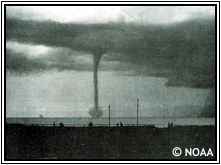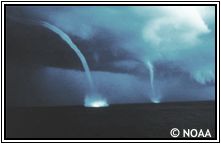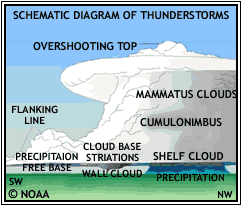|
|
 |
Home / Authors
/ Ralph Doolin
| |
 |
| Sailing through a
Waterspout |
| |
| |
|
| |

|
| | We were
on the Intracoastal Waterway in southwest Florida on July
15 of this year. Heading out for our normal
Saturday daysail on our 1988, 25-foot O'Day, we had a
large crew of seven on board. We had noted that it was very
stormy north of us, but the clouds seemed to be moving east
and our route was taking us to the south. We were only about
half an hour into our sail when we noticed the storm was in
fact moving toward us and was catching up to us quite quickly.
As we discussed what to do next, a waterspout touched down
about 200 yards to our north. I had never seen a tornado or a
waterspout before—it had us all mesmerized! The spout was
about 50 feet across and it came toward us very fast. Even
though there were other boats on the Waterway, we got hit. The
only thing we had time to do was let out the sails and hang
on—that was it! The jib got hung up and we couldn't free it.
When the spout hit the boat, it instantly tore our bimini top
off and with the jib still hung up, the mast went right into
the water and stayed there for what seemed like 30 seconds.
The captain, another crew person, and I were in the bow while
the remaining four crew were scattered from amidships to the
stern during the initial onslaught, and how they hung on, I
don't know—but one man didn't, and he went overboard. As the
center of the spout passed over us, the boat righted itself.
Fortunately, the man in the water was only a few yards away,
which gave him a front-row seat to watch what happened next.
| |

|
| | The
back side of the spout hit us and down we went—again! We got
turned around and headed west. The wind was so powerful this
time that it broke our standing rigging off the boat and bent
the mast. This whole episode from beginning to end lasted
about five minutes.
The waterspout was an experience I will never forget. It
was only by the grace of God that no one on the boat was
injured. We later heard reports that three waterspouts had
touched down in the vicinity of our daysail, but we only saw
the one—that was enough. I have nothing to offer to other
sailors that could help them if they are caught in this
situation except to say that if you see a spout near you, drop
your sails and pray!
Sharon's
experience seems to be a fairly typical account of
encounters between sailboats and waterspouts. In a somewhat
more famous event, John Caldwell was sailing on his
boat, The Pagan, somewhere in the mid-Pacific on a
July morning when he saw a waterspout. Having heard that
spouts have hurricane-force winds inside, whirlpools at their
bases that could suck a ship under, and a solid wall of water
that shoots up into the clouds, Caldwell did a truly
remarkable thing—he headed directly for the spout in an effort
to get under it. Most people would consider that Caldwell was
either very brave or very stupid, especially given his
location in the mid-Pacific.
Caldwell tells his tale "On Sailing through a Waterspout,"
in the Journal of Meteorology, 11:236, 1986.
"Pagan was swallowed by a cold, wet fog and
whirring wind. The decks tilted. A volley of spray swept
across the decks. The rigging howled. Suddenly it was dark as
night. My hair whipped my eyes, I breathed wet air, and the
hard, cold wind wet me through. Pagan's gunwales
were under and she pitched into the choppy seaway. There was
no solid trunk of water being sucked from the sea; no
hurricane winds to blow down sails and masts; and no whirlpool
to gulp me out of sight. Instead, I sailed into a high, dark
column from 75 to 100 feet wide, inside of which was a damp,
circular wind of 30 knots, if it was that strong. As suddenly
as I had entered the waterspout, I rode out into bright, free
air. The high, dark wall of singing wind ran away. For me,
another mystery of the sea was solved."
What is a waterspout? Obviously it is similar in nature to
a tornado over land and many sailors think of it in those
terms. But the waterspout is a unique weather phenomenon that
occurs over a body of water—no water, no spout. It is much
like a dust devil in that its formation is enhanced by
unstable weather conditions. These conditions are usually
created by warm water temperatures and high humidity in the
first few thousand feet of the air above the water's surface.
Because of these requirements, waterspouts are most likely to
occur near the coastline in the summer, though sometimes a few
form as early as mid-spring or as late as mid-autumn, and at
least according to John Caldwell, they can occur in the
mid-Pacific.
If you think that these funnel clouds are reaching down
from above, you are not alone. Many people perceive lightning
as traveling from cloud to ground, but we now know that both
waterspouts and lightning emanate upward from the ground,
rather than descending from the base of clouds, as is the case
with a tornado. There is also a difference between a true
waterspout and the case of a land-based tornado that moves
across a body of water such as a large lake. Stories of it
raining fish and frogs are not totally inaccurate with the
latter, and tornados formed in this way can be just as
devastating as their counterparts on land.
I have personally seen many true waterspouts off the coasts
of South Carolina and Georgia in the summer. One time I
actually saw three, what you might call triplets, side by side
on the leading edge of a squall line off Folly Beach—very
impressive. These true waterspouts that form over water are
defined as an intense, vertical column, or whirlpool, of low
pressure that develops on the sea surface and extends upward
to a cloud base. Waterspouts have the potential to be
extremely dangerous, with an average life cycle ranging from
two to 20 minutes. They travel at an average speed between 10
and 15 knots, with maximum wind speeds of hurricane force or
greater, however briefly realized. John Caldwell was very
lucky, if we can believe his story.
| |

|
| | One of
the largest and most famous waterspouts was observed in
Massachusetts on August 19, 1896, and was witnessed by
thousands of vacationers and several scientists. It is likely
that it looked much like the spout in the old photo to the
right, which was taken of an equally famous waterspout near
Martha's Vineyard. The height of this waterspout was estimated
to be about three-quarters of a mile and its width 750 feet at
the crest, 120 feet at the center, and over 200 feet at the
base. The spray surrounding the funnel near the water's
surface was about 600 feet wide and 360 feet high. This famous
spout lasted about 35 minutes, disappearing and reappearing
three times, but most waterspouts are smaller with much
shorter life spans. This exceptional spout is an example of
those that are spawned by squall conditions associated with
thunderstorms, and in this way are similar to those same
conditions that produce tornadoes over land. The highest
waterspout ever recorded reached a height of over
one-and-a-half kilometers (about one mile)—more than four
times the height of the world's tallest building.
| |

|
| | A
recent waterspout in Tampa, FL, on June 19 made history in a
unique way. As Tiger Woods was smashing golf records,
including one that had stood since 1862, to win the US Open
Golf Tournament in Pebble Beach, CA, local Tampa TV station
WFLA-Channel 8 cut away to a weather bulletin. While Woods was
missing his birdie putt, golf fans in Tampa Bay were looking
at a picture of a waterspout over their home waters. Viewers
were so irate at missing Wood's historic finish after nearly
24 hours of network coverage that they telephoned and e-mailed
more than 3,000 complaints to the television station and local
newspapers. The waterspout did no damage, but it did put the
TV station in the Sports Broadcasting Screw-up Hall of Fame.
What should you do to avoid waterspouts? You can begin by
staying well informed about the weather. If you do not have
VHF on board, a portable weather radio designed to receive
NOAA weather broadcasts should always be aboard your boat—and
you should listen to it regularly.
Since
waterspouts tend to come from clouds with dark, flat bottoms
when there is just the first hint of rain, you should be extra
vigilant when these conditions develop. If a waterspout heads
your way, try to escape by going at right angles to its path.
The greatest danger, if you are enveloped by a waterspout, is
from personal injury caused by flying debris, just as with a
tornado. Going below, getting low in the boat, and possibly
even getting into the water might be a good practice.
Definitely put on a PFD, in the event that you do end up in
the water, and as protection against flying objects. You
probably shouldn't take your cue from John Caldwell and his
mid-Pacific exploits aboard Pagan.
|
Five Stages of Waterspout
Development
| |

|
| | Meteorologists
have been studying the formation of waterspouts for
years. NOAA Senior Scientists have distinguished five
stages of waterspout development:
- The "dark spot" phase is one in which a
prominent, circular/light-colored disk appears on the
surface and is surrounded by a larger dark area of
indeterminate shape. While not visible to the mariner
at sea level, the presence of a dark spot and an
associated funnel cloud overhead indicate that a
complete funnel is present.
- The "spiral pattern" phase represents a
pattern of light and dark-colored bands spiraling out
from the dark spot that develops on the sea surface.
- The "spray ring" phase creates a dense,
swirling ring of sea spray appearing around the dark
spot with what appears to be an "eye." When the wind
speeds reach approximately 40 miles per hour, they
begin to disperse the spray upward in a circular
pattern known as the spray vortex.
- In the "mature vortex" phase, the
waterspout, which is now visible from the sea surface
upward to the overhead cumuli-form cloud base,
achieves maximum organization and intensity.
- With the "decay" phase, the funnel and
spray vortex begin to dissipate as the inflow of warm
air into the vortex weakens. Frequently, rain showers
that develop nearby create a downdraft of cooler air
that accelerates the progression of the decay phase.
Mariners whose vessels have been hit by waterspouts
during the decay stage have reported being drenched
with a combination of salt and rainwater.
—courtesy of NOAA
|
| |
 |
|
 | |
|















